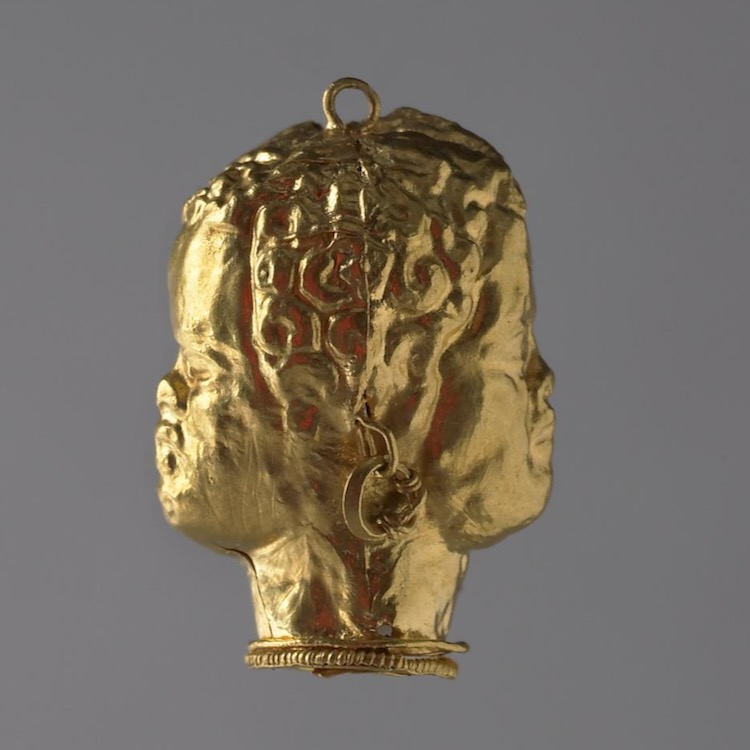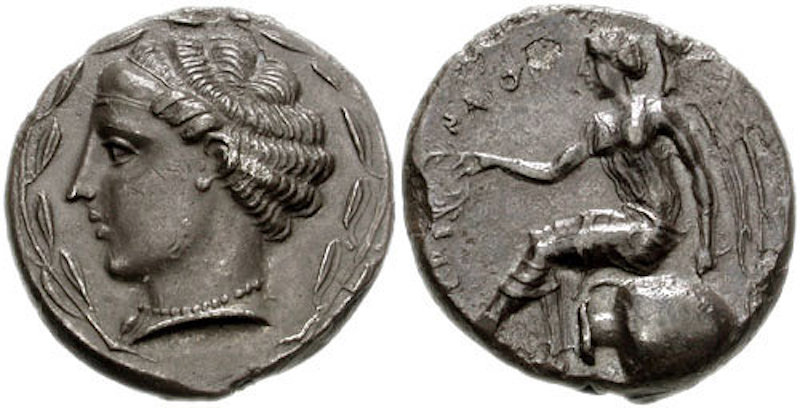The British Museum houses a treasure trove of riches from all over the world. I had visited the venerable institution on several occasions many years ago, enjoying its vastness. But on a recent trip to London, I returned with a purpose and headed straight for Room 73. I wanted to see the collection from the ancient Greek settlements in Southern Italy, what’s known as Greater Greece. I could write a lifetime of blogposts with what was on display, but for this post, I would like to focus on the Treasure of Sant Eufemia. Who would have thought to find Calabrian gold in London?
LAMEZIA TERME: NICASTRO, SAMBIASE, SANT’EUFEMIA VETERE
Many visitors to Calabria fly in and out of Lamezia Terme Airport, located in the center of the region. Those who have done a bit of reading beforehand have a sense that Reggio Calabria, Crotone and Sibari, to name a few, were ancient Greek cities, but Lamezia Terme? Look again at the airport code: SUF… Sant’Eufemia. And then look at a map and you’ll see that it looks out to the Gulf of Sant’Eufemia. No, the Greeks didn’t take the name of a saint – that came many centuries later. But there was an ancient Greek city named Terina in the area, founded in the 5th-century BC by Kroton (modern Crotone). Judging by the gold artifacts at the British Museum, the city flourished.
Lamezia Terme encompasses a rather broad territory, made up of the formerly independent municipalities of Nicastro, Sambiase and Sant’Eufemia Vetere, near where the gold was found. From the area excavated, it would seem that ancient Terina may also have occupied the territory of neighboring Nocera Terinese. More digging is necessary, but suffice it to say, that these towns were founded by the descendants of ancient peoples.
TESORO DI SANT’EUFEMIA – TREASURE OF SANT EUFEMIA
As many of these stories go, there was a heavy rainfall, and the village idiot happened to notice shiny objects poking above the surface in a two-meter ditch, located in an olive grove. He shared the discovery with a pair of unscrupulous buddies, who dug amidst pieces of pottery and bones, gathered up the hoard and brought it to the estate keeper, who crushed and sold most of it for the value of the precious raw materials.
Almost twenty years later, various versions of the story were attested to by the mayors of Nicastro, Sambiase and Gizzeria. In one narrative, two peasants, intent upon gathering kindling, came upon a large jar buried in the ground that, when broken, revealed the great wealth. Spicing up the mystery, there’s also an account that the discovery included pieces of armor belonging to Agathocles, Greek tyrant of Siracusa from the 4th century BC, thus sparking a local legend. Interestingly, they seem to be in agreement about the date, 8 April 1865.
In 1897, Antonio Francica, who inherited the property where the discovery took place, sold what remained of the Sant Eufemia Treasure to the British Museum through a source in Rome. With a description of the objects came a recounting as to how his predecessor, Pasquale Francica, upon hearing of the find, tracked down the objects and bought back what was left at an exorbitant price. I suppose the assertion that he had paid dearly for the objects was to exonerate him from, in turn, selling off the goods at what must have been a very good price for himself.
“SANTA EUFEMIA MASTER” OF TERINA
The ancient Calabrian gold pieces were initially thought to be from workshops in Taranto, long recognized as a center of goldsmithing. However, upon closer inspection, the British Museum’s classical archeologist Dyfri Williams, Keeper of Greek and Roman Antiquities for many years with a specialty in ancient Greek metalwork, determined that Terina had its own workshop, characterized by a distinct stylistic element of flattened curly wire to embellish the filigree florals typical of Southern Italian pieces.
Williams selected several works by the “Santa Eufemia Master” for his book Greek Gold: Jewellery of the Classical World that he published in 1994 together with jewelry historian Jack Ogden. He considered the Terina jewelry to be amongst the most important examples of gold workmanship in Magna Graecia. And perhaps could have been the largest find before most of the pieces were destroyed.
The jewelry has been dated to the 4th century BC, specifically 330-300 BC.
GOLD JEWELRY FROM CALABRIA
Elegance would be the word to describe the “gold diadem,” the piece that receives the most attention. Archeologists say that the sheet-gold headpiece has the signs of being worn – delicate workmanship, yet sturdy, with what appears to be ancient repairs to the side strap. The central pediment has been soldered to the longer band. The attractive filigree design is crowned, so to speak, with an embossed head – the experts hazard Helios, the sun god, or perhaps a gorgon. If I were to don the diadem, I’d go with Helios.
The double-sided golden heads also attract interest, characterized by the British Museum as a “pendant in the form of the heads of two African women set back to back.” The pendant is most likely an earring. When worn, the heads would face front and back, and apropos, they share a rather large golden hoop earring.

Double-sided gold earring © The Trustees of the British Museum (Creative Commons International CC BY-NC-SA 4.0)
The “gold oval box pendant and chain with lion-head terminals” is quite an impressive piece. Apparently, there are attachment holes with wires on both sides of the ornate box. The lion-headed chain is a work of art in itself. What might a woman have kept in this exquisite box, decorated on both sides, held close to her chest, over 2,000 years ago?

Gold box pendant and chain with lion-head terminals © The Trustees of the British Museum (Creative Commons International CC BY-NC-SA 4.0)
The Treasure of Sant Eufemia also contained several sections of gold belts, made of substantial sheet gold, shaped with ridged bands. They certainly would have made a splash when worn, which would have been quite rare, as only a handful of golden waistbands from ancient Greece have been found.
Other gold objects include six short chains with three pendants, a ring with the bust of Athena, a scarab ring, a fluted column, earring charms in the shape of women’s heads, gold discs and additional smaller pieces.

Other gold pieces: Sections of chain with pendants in the form of a shell, an amphora and perhaps a flower bud, Element of a necklace decorated with a filigree flower, two crumpled gold discs, Ring with the bust of Athena, Scarab with Eros playing the pipes, Fluted column with palmette decoration
TERINA, ANCIENT GREEK SOCIETY
Archeologists frequently turn to vase paintings for a window on the Greek world. How did the people dress? What did they do? In the 1950s, a red-figured vase was found in a female burial site in Gizzeria, neighbor of Lamezia Terme, with images of lavishly dressed individuals, wearing jewelry and belts similar to what was found in the Treasure of Sant Eufemia. Another attestation as to the level of Terina’s wealth came in the form of a will, written on a bronze tablet, outlining possessions and acknowledging the type of hierarchy that could only be found in a well-developed society.
Terina also minted its own silver coins from 460 to 275 BC, as well as in bronze in a final phase. Ligeia, the local siren, is featured on the obverse. As the story goes, she was thrown ashore by the waves of the Tyrrhenian Sea after attempting to bewitch Ulysses through song and was buried by sailors in Terina. On this coin, dating from 440-425 BC, the beautiful Ligeia is pictured with an elaborate hairstyle, headband and necklace, surrounded by an olive branch. On the reverse, Nike sits on a water jar and holds a wreath in her extended hand.

Ancient silver coin from Terina, c. 440-425 BC (Courtesy of the Classical Numismatic Group, Wikimedia CC BY-SA 2.5)
General excavations in the territory began in 1997, and a residential area has been uncovered, but the mystery remains as to Terina’s exact location. The Museo Archeologico Lametino in Nicastro’s historic center is dedicated to the history of the area, with finds from recent archeological research, excavations and happenstance discoveries, as well.
Over a century from when the gold was sold to the British Museum, the Treasure of Sant Eufemia returned to Calabria in November 1998, remaining on display at the Lametino Archeological Museum until January 1999. Today, the museum in Nicastro has photos and the story of the Tesoro di Sant’Eufemia on informational panels, but to view the gold, you need to go to London.
VISITING THE BRITISH MUSEUM
Terina with it’s golden Treasure of Sant Eufemia is just one of many ancient cities represented in the British Museum’s permanent display of Greek settlements in Southern Italy. Surprisingly, my visit wasn’t as calm as I had anticipated. I reserved an entrance time as directed on the internet, and luckily there wasn’t a line. Inside, however, I had to keep on my toes, dodging rogue baby carriages, running children, and tourists bustling from one “highlight” to the next. (Soon there will be a map with “best artifacts for selfies” marked…)
The Treasure of Sant Eufemia wasn’t on the museum’s “must see” list, and truth be told, I was surprised there were as many people as there were in the unairconditioned wing. In fact, it was good that I went first thing in the morning as I found out that they regularly closed that section due to the afternoon heat.
So, after a fruitful immersion in Southern Italy, I made my way to the museum’s restaurant. No, I didn’t order the pizza. I figure, when in Rome…

An Earl Grey tea-soaked raisin scone and a Somerset farm butter scone with Cornish clotted cream and strawberry jam… and tea!
Visit Calabria or Basilicata on one of my SMALL-GROUP TOURS, beautiful Southern Italian regions, outstanding food and historical treasures within their context!
Cover photo: Gold diadem with elaborate filigree decoration and a small head of a woman in low relief © The Trustees of the British Museum, Creative Commons International (CC BY-NC-SA 4.0)
Read all about the fascinating Calabrian region in my book Calabria: The Other Italy, described by Publisher’s Weekly as “an intoxicating blend of humor, joy, and reverence for this area in Italy’s deep south,” and explore Calabria’s northern neighbor in my book Basilicata: Authentic Italy, “recommended to readers who appreciate all things Italian” by the Library Journal.
Follow me on social media: Basilicata Facebook page, Calabria: The Other Italy’s Facebook page, Karen’s Instagram and Karen’s Twitter for beautiful pictures and information.
Sign up below to receive the next blog post directly to your email for free.











Comments 6
what an informative and gorgeous post!
Author
Happy you enjoyed it.
Who doesn’t like to find out more about the jewelry people wore so long ago?
Very interesting…& I was (in addition to the jewelry) coveting that scone! 😁
Author
Jewelry is so personal. I remember going to an astronaut exhibit when I was very young and the guide was very focused on the amazing technology that got them into outer space, but I was fascinated by the little display of their personal effects and the food pouches. The scone is much better!
What a wealth of information on a very complex subject. Wonderful writing, takes me right there. I bet her tours are fabulous!
Author
Thank you, glad you were able to visit virtually! My guests do love my tours…